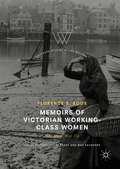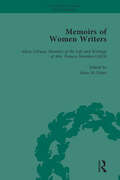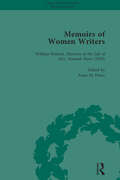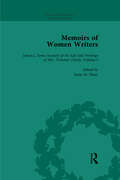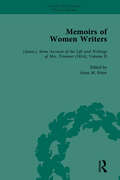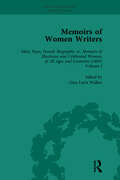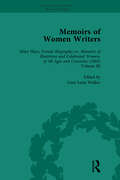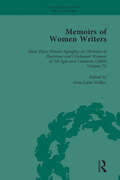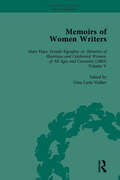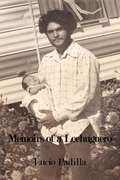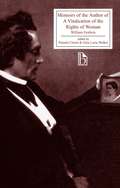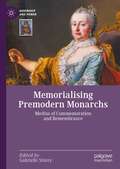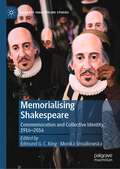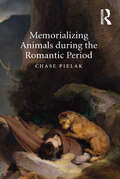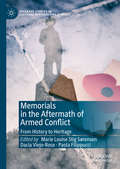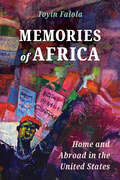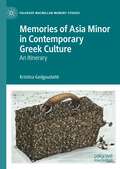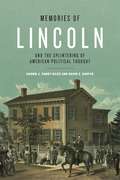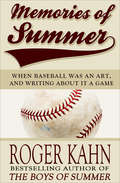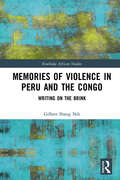- Table View
- List View
Memoirs of Scandalous Women, Volume 5
by Dianne DugawThese memoirs all come from women forced to live lives of impropriety, often after ill-treatment from unscrupulous men. Their tales of survival in the face of extreme hardship and privations make inspirational and compelling reading.
Memoirs of Victorian Working-Class Women
by Florence S. BoosThis volume is the first to identify a significant body of life narratives by working-class women and to demonstrate their inherent literary significance. Placing each memoir within its generic, historical, and biographical context, this book traces the shifts in such writings over time, examines the circumstances which enabled working-class women authors to publish their life stories, and places these memoirs within a wider autobiographical tradition. Additionally, Memoirs of Victorian Working-Class Women enables readers to appreciate the clear-sightedness, directness, and poignancy of these works.
Memoirs of Women Writers, Part I, Volume 1
by Gina Luria Walker Anna M FitzerThis volume is a review of the autobiographical account Alicia LeFanu, Memoirs of the Life and Writings of Mrs. Frances Sheridan, which sheds light on the controversial role of the female writers in the early nineteenth century.
Memoirs of Women Writers, Part I, Volume 2
by Gina Luria Walker Anna M FitzerThis book is about Mrs. Hannah More, who had acted as a controversial patron to Ann Yearsley, and had used her own reputation as a poet in support of the abolitionist cause. It is the collaborative effort of Roberts, Bickersteth and Seeley that testifies the complexity of her enduring influence.
Memoirs of Women Writers, Part I, Volume 3
by Gina Luria Walker Anna M FitzerThis book is about Mrs. Sarah Trimmer and her charitable work. It is a principal source of reference for the work she undertook as an author, philanthropist and pioneer in the promotion and institution of educational opportunities for impoverished children in the early nineteenth century.
Memoirs of Women Writers, Part I, Volume 4
by Gina Luria Walker Anna M FitzerThis book is the second volume about Mrs. Sarah Trimmer and her charitable work. It contains selected content on her life and writings with original letters, her meditations and prayers for impoverished children in the early nineteenth century.
Memoirs of Women Writers, Part II, Volume 5
by Gina Luria WalkerThis book is fifth of the six-volume modern scholarly edition on the stories of real women's experiences. Written by the autodidact Mary Hays, it attests to the existence of active, learned and powerful women who produced new knowledge and made genuine contributions to cultural capital.
Memoirs of Women Writers, Part II, Volume 6
by Gina Luria WalkerThis book is second volume of Mary Hays's Female Biography; a scholarly edition on the stories of real women's experiences, such as those of Elizabeth Bland and Boadecia. It attests to the existence of active, learned and powerful women who produced new knowledge and contributed to cultural capital.
Memoirs of Women Writers, Part II, Volume 7
by Gina Luria WalkerThis volume is a review of the autobiographical account Mary Hays, Female Biography; or, Memoirs of Illustrious and Celebrated Women, of All Ages and Countries (1803), Volume III, which sheds light on the controversial role of the female writers in the early nineteenth century.
Memoirs of Women Writers, Part III vol 10
by Gina Luria WalkerMary Hays was a radical feminist whose writings brought her to the attention of her contemporaries William Blake, Thomas Paine, Mary Wollstonecraft and William Godwin. Her Female Biography is an ambitious and acclaimed work, covering the lives of 294 women.
Memoirs of Women Writers, Part III vol 8
by Gina Luria WalkerMary Hays was a radical feminist whose writings brought her to the attention of her contemporaries William Blake, Thomas Paine, Mary Wollstonecraft and William Godwin. Her Female Biography is an ambitious and acclaimed work, covering the lives of 294 women.
Memoirs of Women Writers, Part III vol 9
by Gina Luria WalkerMary Hays was a radical feminist whose writings brought her to the attention of her contemporaries William Blake, Thomas Paine, Mary Wollstonecraft and William Godwin. Her Female Biography is an ambitious and acclaimed work, covering the lives of 294 women.
Memoirs of a Lechuguero
by Lucio PadillaThe autobiography depicts the life of a Mexican migrant farm worker who overcomes his disadvantages to be the first college graduate in his family. The veteran lettuce harvester suffers a crippling, job related injury that leaves him unable to work. During the painful recovery, he goes through a series of flashbacks of key events leading to the injury. Inspired by a blind man and a former teacher, he finds the turning point of his life. <P><P>Lucio Padilla came to the United States at age nine with his family to work the fields of central and southern California. As a teenager he endured the hardships and abuses that farm workers experience. He dropped out of school at age fifteen to become a lechuguero (lettuce harvester). He married at age sixteen with his sweetheart Maria Elena. Together they faced their disadvantages to raise a family and give them better opportunities. The story portrays the farm worker's way of life; it illustrates the harsh living conditions and the enslaving routines. Particular phrases in Spanish are used to illustrate the language, culture, and values of the farm worker's families.
Memoirs of the Author of A Vindication of the Rights of Woman
by William GodwinGodwin worked with Mary Wollstonecraft Shelley at the turn of the 19th century to advocate for social progress. In these, his memoirs, he reflects on that work as well as his and Shelley's various other passions. The work here was severely criticized at the time and long unavailable. Here, Clemit and Walker provide context, explication, and an introduction to Godwin's memoir.
Memorial de Aires
by Machado De AssisThe last novel by Brazil's most important writer, Memorial de Aires doesn't have a strict plot. It is structured as a kind of diarly of Counselor Aires, a retired diplomat. His notes tell several stories including that of Tristão, who falls in love with and marries a young widow, Fidália. After their marriage, the couple go to Europe, leaving their friends with only sadness and memories. Known as the novel that best reflects the personality and life of Machado de Assis, Memorial de Aires substitutes the irony and sarcasm of his earlier novels with a compassionate and melancholy tone. Some critics count the novel as a literary and human testament from the master of Brazilian letters.
Memorialising Premodern Monarchs: Medias of Commemoration and Remembrance (Queenship and Power)
by Gabrielle StoreyThis book examines the legacies and depictions of monarchs in an international context, focusing on both self-representation and commemoration by others. Spanning ancient India through to eighteenth-century Russia, this volume offers several case studies to demonstrate trends and patterns in how different societies chose to commemorate and remember their rulers in a variety of mediums. Contributions highlight several lesser known rulers, alongside more famous ones such as Henry VIII of England, to develop a deeper understanding of how memory and monarchy functioned when drawn together. Memorialising Premodern Monarchs brings to the fore the importance of memory and memorialisation when considering the legacies and records of past rulers and their societies, and allows a deeper reflection on how these rulers live on through the historical record and popular culture.
Memorialising Shakespeare: Commemoration and Collective Identity, 1916–2016 (Palgrave Shakespeare Studies)
by Edmund G. C. King Monika SmialkowskaThis book is the first comprehensive account of global Shakespeare commemoration in the period between 1916 and 2016. Combining historical analysis with insights into current practice, Memorialising Shakespeare covers Shakespeare commemoration in China, Ukraine, Egypt, and France, as well as Great Britain and the United States. Chapter authors discuss a broad range of commemorative activities—from pageants, dance, dramatic performances, and sculpture, to conferences, exhibitions, and more private acts of engagement, such as reading and diary writing. Themes covered include Shakespeare’s role in the formation of cultural memory and national and global identities, as well as Shakespeare’s relationship to decolonisation and race. A significant feature of the book is the inclusion of chapters from organisers of recent Shakespeare commemoration events, reflecting on their own practice. Together, the chapters in Memorialising Shakespeare show what has been at stake when communities, identity groups, and institutions have come together to commemorate Shakespeare.
Memorializing Animals during the Romantic Period
by Chase PielakEarly nineteenth-century British literature is overpopulated with images of dead and deadly animals, as Chase Pielak observes in his study of animal encounters in the works of Charles and Mary Lamb, John Clare, Samuel Taylor Coleridge, Lord Byron, and William Wordsworth. These encounters, Pielak suggests, coincide with anxieties over living alongside both animals and cemeteries in the late eighteenth and early nineteenth-centuries. Pielak traces the linguistic, physical, and psychological interruptions occasioned by animal encounters from the heart of communal life, the table, to the countryside, and finally into and beyond the wild cemetery. He argues that Romantic period writers use language that ultimately betrays itself in beastly disruptions exposing anxiety over what it means to be human, what happens at death, the consequences of living together, and the significance of being remembered. Extending his discussion past an emphasis on animal rights to an examination of animals in their social context, Pielak shows that these animal representations are both inherently important and a foreshadowing of the ways we continue to need images of dead and deadly Romantic beasts.
Memorials in the Aftermath of Armed Conflict: From History to Heritage (Palgrave Studies in Cultural Heritage and Conflict)
by Marie Louise Stig Sørensen Dacia Viejo-Rose Paola FilippucciThrough case studies from Europe and Russia, this volume analyses memorials as a means for the present to make claims on the past in the aftermath of armed conflict. The central contention is that memorials are not backward-looking, inert reminders of past events, but instead active triggers of personal and shared emotion, that are inescapably political, bound up with how societies reconstruct their present and future as they negotiate their way out of (and sometimes back into) conflict. A central aim of the book is to highlight and illustrate the cultural and ethical complexity of memorials, as focal points for a tension between the notion of memory as truth, and the practice of memory as negotiable. By adopting a relatively bounded temporal and spatial scope, the volume seeks to move beyond the established focus on national traditions, to reveal cultural commonalities and shared influences in the memorial forms and practices of individual regions and of particular conflicts.
Memories of Africa: Home and Abroad in the United States (Atlantic Migrations and the African Diaspora)
by Toyin Falola2023 CHOICE Outstanding Academic TitleMemories of Africa: Home and Abroad in the United States suggests a new lens for viewing African Diaspora studies: the experiences of African memoirists who live in the United States. The book shows how African Diaspora memoirs beautifully and grippingly depict the experiences of African migrants over time through political, social, and cultural spheres. In reading African Diaspora memoirs from the transatlantic slave trade period to the present, a reader can understand the complexity of the African migrant legacy and evolution.Author Toyin Falola argues that memoirs are significant not only in their interpretation of events conveyed by the memoirists but also in demonstrating how interpersonal and human the stories told can be. Memoirs are powerful because they are emotionally captivating and because important themes and events circulate around a particular person (in this case, the memoirist). Undoubtedly, a memoir is significant because it can teach anyone about a part of the human experience, even if the “facts” are not described without bias. Through this sort of narrative, the reader cannot help but enter into the memoirist’s mind and, therefore, feel more empathy for them. In doing so, the reader can “feel” what the memoirist feels and “see” what the memoirist sees as clearly as is humanly possible. In this way, the historical events and life lessons become tangible and poignantly real to the reader.
Memories of Asia Minor in Contemporary Greek Culture: An Itinerary (Palgrave Macmillan Memory Studies)
by Kristina GedgaudaitėThe Greco-Turkish War (1919-1922) in Asia Minor and the Population Exchange that followed led to the forced displacement of more than 1.5 million people who became entangled in the nation-building processes of both Greece and Turkey. This book examines the memories that shaped Asia Minor refugee identity, focusing on the ways in which these memories continue to reverberate in contemporary Greek culture. It explores how memories of Asia Minor frame wider social debates, foster affective alliances, inform different notions of belonging and provide a toolkit for addressing contemporary concerns. Taking the reader across a wide range of cultural works—history textbooks, comics, theatre, documentary and fiction films, news footage and photography—the book shows how these works have become means for individuals and communities to contribute to the process of history-making. While keeping its focus on present-day Greece, Memories of Asia Minor joins wider global debates over contested pasts, legacies of war and refugeehood.
Memories of Lincoln and the Splintering of American Political Thought (Rhetoric and Democratic Deliberation #14)
by Shawn J. Parry-Giles David S. KauferIn the aftermath of the Civil War, Republicans and Democrats who advocated conflicting visions of American citizenship could agree on one thing: the rhetorical power of Abraham Lincoln’s life. This volume examines the debates over his legacy and their impact on America’s future.In the thirty-five years following Lincoln’s assassination, acquaintances of Lincoln published their memories of him in newspapers, biographies, and edited collections in order to gain fame, promote partisan aims, champion his hardscrabble past and exalted rise, and define his legacy. Shawn Parry-Giles and David Kaufer explore how style, class, and character affected these reminiscences. They also analyze the ways people used these writings to reinforce their beliefs about citizenship and presidential leadership in the United States, with specific attention to the fissure between republicanism and democracy that still exists today. Their study employs rhetorical and corpus research methods to assess more than five hundred reminiscences.A novel look at how memories of Lincoln became an important form of political rhetoric, this book sheds light on how divergent schools of U.S. political thought came to recruit Lincoln as their standard-bearer.
Memories of Summer: When Baseball Was an Art, and Writing about It a Game
by Roger KahnThe legendary sportswriter&’s memoir of Brooklyn, baseball, and a life in journalism: &“Simply put, this is a marvelous book&” (Kirkus Reviews). In this book, the bestselling author of The Boys of Summer shares stories of his Depression-era Brooklyn childhood, his career during a golden era of sports, and his personal acquaintances with a wide range of great ballplayers. His father had a passion for the Dodgers; his mother&’s passion was for poetry. Young Roger managed to blend both loves in a career that encompassed writing about sports for the New York Herald Tribune, Sports Illustrated, the Saturday Evening Post, Esquire, and Time. Kahn recalls the great personalities—Leo Durocher, Mickey Mantle, Willie Mays, Jackie Robinson, Red Smith, Dick Young, and many more—and recollects the wittiest lines from forty years in dugouts, press boxes, and newsrooms. &“A master at evoking a sense of the past . . . A pleasing potpourri of autobiography, professional memoir, and anecdotal baseball history . . . Of special note to journalism buffs is Kahn&’s account of his role in the inception of Sports Illustrated.&” —Booklist &“As a kid, I loved sports first and writing second, and loved everything Roger Kahn wrote. As an adult, I love writing first and sports second, and love Roger Kahn even more.&” —David Maraniss, Pulitzer Prize–winning journalist and author &“Roger Kahn is the best baseball writer in the business.&” —Stephen Jay Gould, New York Review of Books
Memories of Violence in Peru and the Congo: Writing on the Brink (Routledge African Studies)
by Gilbert Shang NdiThe book presents an intertextual and comparative analysis of memories of violence in Peruvian and Congolese Literature. Examining a variety of novels that offer insightful representations of violence in their respective historical settings, the author argues that similar historical experiences between Latin America and Africa engender ethical/aesthetic responses and enhance trans-continental critical dialogues in comparative literary studies. In the same way that the drama of the Congo has become the symbolic open wound of (post)colonial dispensation in Africa, Spanish conquest in Latin America also produced spaces where the legacy of colonialism is strongly visible and memorable, providing fertile ground for the reproduction of violence. This book explores the concept and reality of violence beyond its most obvious manifestations, demonstrating how in the colonial contexts of Peru and the Congo, violence was a function of (post)colonial power dynamics and deeply engrained socio-political, economic and cultural ordering and othering. From this perspective, the work considers and re-examines theoretical contributions from authors such as John Galtung, Michel Foucault, Immanuel Wallerstein, Anibal Quijano, Frantz Fanon, Achille Mbembe, Eboussi Boulaga, Pierre Nora, Susan Sontag, Stevan Weine, Cathy Caruth and Nelson Maldonado-Torres. This book will be of interest for scholars working on how violence is explored and represented in literature and other art forms.

